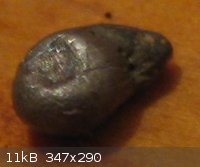Bitburger
Harmless

Posts: 41
Registered: 23-7-2011
Location: Belgium
Member Is Offline
Mood: Experimental
|
|
Molybdenum metal preparation.
I have some boring chemicals (like sodium molybdate dihydrate, mangenese(II)sulphate,...)
Because my claisen adapter is broken, I was thinking what I could do today. My conclusion was to try to make pure transition metals by mixing these
compounds with carbon (powder) and heat them up OUTSIDE to create carbon monoxide and to obtain the pure metal. I had also olive oil to prevent
oxidation.
My first experiment was done in a closed steel tube. But I got nearly no formation of the metal, except a little piece of molybdenum. See picture.
Then, I tried in in open air, no results again.
What did I wrong, was the propane-butane flame to weak to melt these compounds and therefore not susceptible to react?
Thanks in advance!

Good to be wrong
|
|
|
redox
Hazard to Others
  
Posts: 268
Registered: 22-2-2011
Location: The Land of Milk and Honey
Member Is Offline
Mood: Chalcogenetic
|
|
What compound exactly did you mix with the carbon? It sounds like you mixed sodium molybdate.
My quite small but growing Youtube Channel: http://www.youtube.com/user/RealChemLabs
Newest video: Synthesis of Chloroform
The difference between chemists and chemical engineers: Chemists use test tubes, chemical engineers use buckets. |
|
|
Bitburger
Harmless

Posts: 41
Registered: 23-7-2011
Location: Belgium
Member Is Offline
Mood: Experimental
|
|
Yes, indeed.
I did also another reaction with carbon and manganese sulphate, but without results.
Good to be wrong
|
|
|
blogfast25
International Hazard
    
Posts: 10562
Registered: 3-2-2008
Location: Neverland
Member Is Offline
Mood: No Mood
|
|
With a melting point for Mo of 2,623 DC (!!!    ) it's very
unlikely that what you show in the picture is molybdenum metal. Reduction of D-block element oxides with carbon is difficult and would require
temperatures way beyond a propane/butane flame. Any produced Mo metal would be in the form of powder or sponge. Think iron making blast furnaces for
the amount of heat needed to reduce these oxides successfully! ) it's very
unlikely that what you show in the picture is molybdenum metal. Reduction of D-block element oxides with carbon is difficult and would require
temperatures way beyond a propane/butane flame. Any produced Mo metal would be in the form of powder or sponge. Think iron making blast furnaces for
the amount of heat needed to reduce these oxides successfully! 
One way of lab-producing crude Mo metal could be the reduction of MoS2 with Al powder (but I need to check the Delta G on this):
MoS2 + 4/3 Al === > Mo + 2/3 Al2S3
If the reaction doesn't yield enough heat to produce liquid Mo metal (prior to cooling of course) then heat output could be boosted by adding extra Al
and S: 2 Al + 3 S === > Al2S3, as a heat booster reaction.
Assuming the first reaction has a negative Delta G (making it thermodynamically feasible), then crude, lump Mo metal should be obtainable this way.
There's also a trisulphide, MoS3, that should potentially work better: MoS3 + 2 Al --- > Mo + Al2S3
[Edited on 2-8-2011 by blogfast25]
|
|
|
watson.fawkes
International Hazard
    
Posts: 2793
Registered: 16-8-2008
Member Is Offline
Mood: No Mood
|
|
What's the solubility of carbon in molten Mo? The Fe-C eutectic has a much lower melting point that pure Fe.
Also, since you want to exclude oxygen, you'll want a flux. Since you're using a metallic crucible, use a basic flux. Olive oil isn't going to make a
particularly good flux.
|
|
|
blogfast25
International Hazard
    
Posts: 10562
Registered: 3-2-2008
Location: Neverland
Member Is Offline
Mood: No Mood
|
|
Watson:
I doubt very much if the heat from a butane/propane flame can provide enough heat to reduce MoO3 (or MoO2 - he didn’t specify the oxide) to metal by
means of carbon. Such a flame allows to just about reduce CuO with carbon but not for instance SnO2. These reductions rely mostly on the change in
entropy (the escaping CO, which has a relatively low enthalpy of formation) and for the term TΔS to be sufficiently negative, you need high T.
See Ellingham Diagrams:
http://en.wikipedia.org/wiki/Ellingham_diagram
Only relatively few d-block elements can be extracted by reduction of their oxides with carbon. I strongly suspect Mo isn’t one of them. It
wouldn’t work with Fe in his conditions either…
|
|
|
watson.fawkes
International Hazard
    
Posts: 2793
Registered: 16-8-2008
Member Is Offline
Mood: No Mood
|
|
Quote: Originally posted by blogfast25  | I doubt very much if the heat from a butane/propane flame can provide enough heat to reduce MoO3 (or MoO2 - he didn’t specify the oxide) to metal by
means of carbon. [...]
Only relatively few d-block elements can be extracted by reduction of their oxides with carbon. I strongly suspect Mo isn’t one of them. It
wouldn’t work with Fe in his conditions either…
|
Oh, I don't think he's got the reduction either. I was leaping ahead to wonder if you couldn't smelt those
molybdates (as ores) in a small cupola.
|
|
|
Bitburger
Harmless

Posts: 41
Registered: 23-7-2011
Location: Belgium
Member Is Offline
Mood: Experimental
|
|
The piece of metal you see is just lead metal.
From PbO/PbO2 you can make lead nitrate (the yellow impurities are soluble in MeOH, lead nitrate isn't)
A simple flame test of the corresponding nitrate gives you the correct answer!
Good to be wrong
|
|
|
blogfast25
International Hazard
    
Posts: 10562
Registered: 3-2-2008
Location: Neverland
Member Is Offline
Mood: No Mood
|
|
Then what was the purpose of making us believe the sample shown was Mo metal???
Quote: Originally posted by Bitburger  | My first experiment was done in a closed steel tube. But I got nearly no formation of the metal, except a little piece of molybdenum. See picture.
|
[Edited on 3-8-2011 by blogfast25]
|
|
|